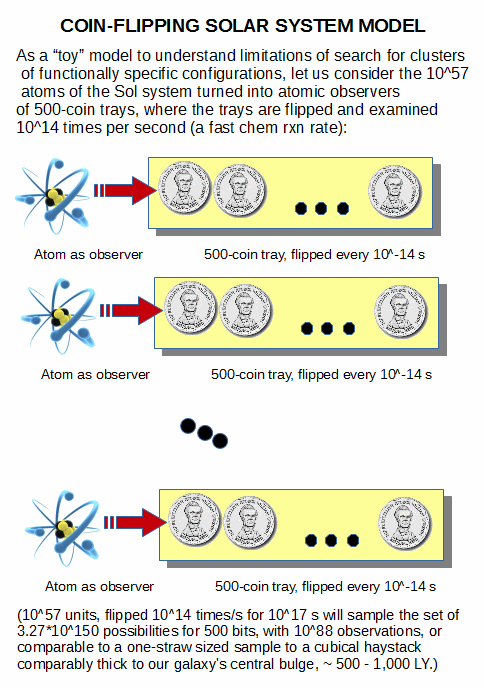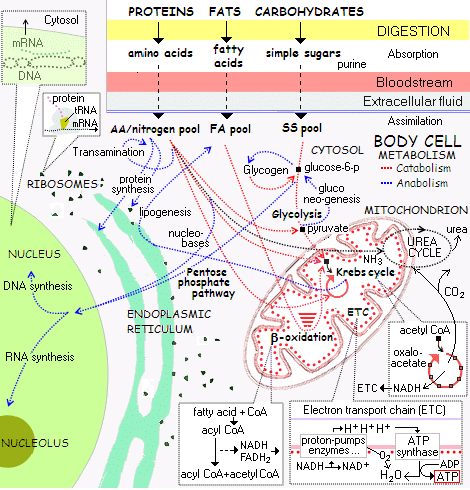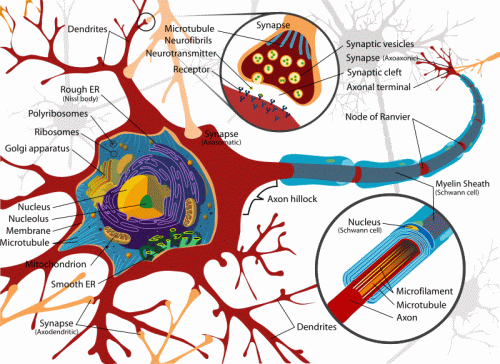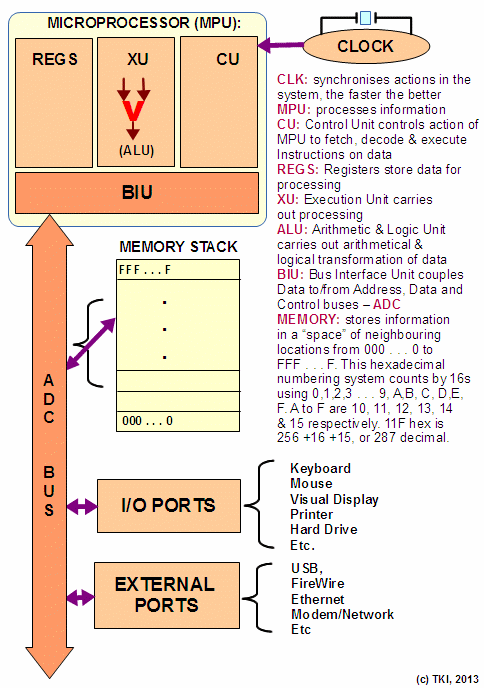Islands of function in a space of configurations, of course, are used as a metaphor for special zones T, which has been visualised at UD as follows, based on the underlying Mathematics of phase spaces and configuration spaces, using among other inputs, Dembski’s remarks in his No Free Lunch:
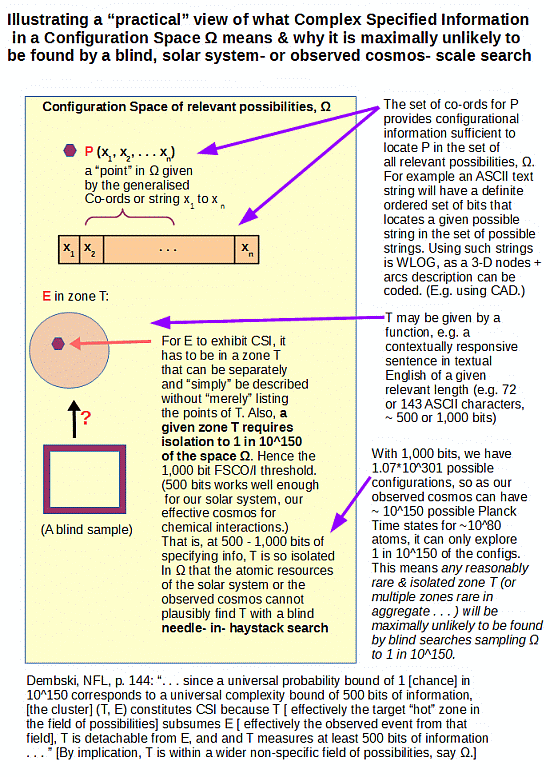 U/D: A way to visualise the search challenge on the gamut of our solar system:
U/D: A way to visualise the search challenge on the gamut of our solar system:
A good way to visualise what is happening in physical, ordinary 3-d space as we inject functionally specific complex organisation and associated information would be to take a pile of lego bricks:
. . . and contrast it with the functional organisation of a lego brick castle:
. . . or that of the “exploded view” nodes-arcs network pattern or “wiring diagram” of an ABU 6500 C3 reel that reveals constraints on spatial organisation, coupling and correctness of parts to achieve its functions as a reel:
. . . or, in a “wiring diagram” view of an oil refinery:

. . . which we may with profit compare to the metabolism cycle of the cell (cf. more complete version here):
. . . as well as the living cell (here, a neuron):
. . . with of course the classic computer and numerically controlled machine paper tape reader making for a useful comparison to the ribosome in action:

. . . as manifesting functionally specific, complex organisation and associated information:
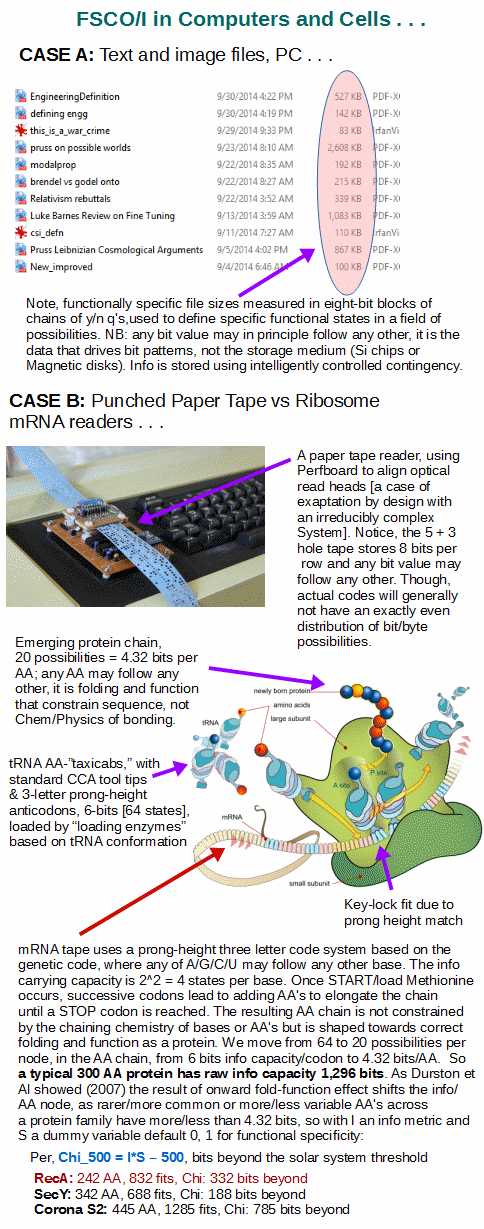 In all of these cases, certain functionally specific clusters of possible configurations exhibit function, but many other possible clumpings or scatterings of the component parts across a pond or a room or a junkyard or a planet or the solar system would not. Where, just the analytical step of taking a workshop bench and mentally splitting it up into tiny location cells then assigning parts of say the fishing reel to them [an example of a set of configurational possibilities], would show that the number of possible scattered states vastly outnumbers the clumped ones, and the non-functional clumped ones, though much smaller, still vastly outnumber the functionally correct ones. Where also, the inevitable variability of parts in such a reel due to tolerances and random effects in the manufacturing process, shows that the functionality of the reel is not a matter of a single-point in the configuration space, there is a cluster of possible node-arc list states E that will fit together and function in accord with the functionality of a reel. (NB: Poor quality reels lack control on tolerances and end up with unreliable performance. But as recently as the classic Lee Enfield .303 rifle, the state of the art was such that the weapon parts were not truly interchangeable. Similarly, the original Bofors 40 mm gun had a lot of required skilled handwork to get units to work. The American copy had to do a serious reworking to be able to effectively mass produce it. But modern NC machines, networked work cells and skilled technically qualified labour are capable of unheard of precision and customisation.)
In all of these cases, certain functionally specific clusters of possible configurations exhibit function, but many other possible clumpings or scatterings of the component parts across a pond or a room or a junkyard or a planet or the solar system would not. Where, just the analytical step of taking a workshop bench and mentally splitting it up into tiny location cells then assigning parts of say the fishing reel to them [an example of a set of configurational possibilities], would show that the number of possible scattered states vastly outnumbers the clumped ones, and the non-functional clumped ones, though much smaller, still vastly outnumber the functionally correct ones. Where also, the inevitable variability of parts in such a reel due to tolerances and random effects in the manufacturing process, shows that the functionality of the reel is not a matter of a single-point in the configuration space, there is a cluster of possible node-arc list states E that will fit together and function in accord with the functionality of a reel. (NB: Poor quality reels lack control on tolerances and end up with unreliable performance. But as recently as the classic Lee Enfield .303 rifle, the state of the art was such that the weapon parts were not truly interchangeable. Similarly, the original Bofors 40 mm gun had a lot of required skilled handwork to get units to work. The American copy had to do a serious reworking to be able to effectively mass produce it. But modern NC machines, networked work cells and skilled technically qualified labour are capable of unheard of precision and customisation.)
All this should be almost obvious to a reasonably informed and experienced person in a technological world.
If you don’t understand, have a chat with your mechanic about how important it is to have the right parts correctly arranged and fitted in for your car engine and transmission to work, etc. Or ask a computer programmer as to whether he would expect random changes in the machine code for a computer program to improve performance.
U/D: let me note, the machine code is adapted to the specific architecture, registers, buses, logic units, operations etc of a machine (I give an abstract outline of a typical architecture here, which again shows the nodes-arcs pattern in action, amenable to register transfer algebra analysis):
As well, it should be quite obvious that the arc-node flow pattern of cellular metabolism and that of the petroleum refinery are essentially similar, and that the fact that the ribosome uses molecular scale parts in its nodes-arcs network does not alter its character of having function emerge from complex, specific functional organisation. Which, let us recall, uses the genetic code as a machine code to control protein assembly.
If that has not helped, maybe, this video tour:
[youtube YM2X1c4K1x0&NR=1]
. . . and this remark by Denton in his Evolution, a Theory in Crisis, will help:
It is those who wish to argue that somehow, functional organisation and its constraints on parts, their arrangement and coupling to achieve function, relative to the possibilities for such parts in general, do not apply to molecular nanomachines as we find them in the cell. Those who are inclined to do so would do well to note the following remarks from two pioneering OOL researchers across the 1970’s, which had significant influence on the eventual formation of a contemporary scientific design school of thought in the early 1980’s:
ORGEL, 1973:
. . . In brief, living organisms are distinguished by their specified complexity. Crystals are usually taken as the prototypes of simple well-specified structures, because they consist of a very large number of identical molecules packed together in a uniform way. Lumps of granite or random mixtures of polymers are examples of structures that are complex but not specified. The crystals fail to qualify as living because they lack complexity; the mixtures of polymers fail to qualify because they lack specificity. [The Origins of Life (John Wiley, 1973), p. 189.]
WICKEN, 1979:
The source of the terms specified complexity, complex specified information [CSI] and the biologically relevant subset, functionally specific, complex organisation and/or associated information [FSCO/I] should be plain. As well,t eh further subset, digitally coded functionally specific complex information, dFSCI, as we find in text strings such as this post, or in the source code of a computer program, or its machine-language object code, or in the coded strings in mRNA or DNA.Where, obviously, a string data structure is a case of a node-arc wiring diagram:
. . . -*-*-*- . . .
Those who wish to deride or dismiss these observations as applied to the world of the cell and more broadly to body plans and the world of biological organisms, therefore properly bear the burden of proof, as we should not allow the fallacy of selective hyperskepticism and its fellow traveller fallacies of irrelevance, to determine our thinking.
However, I must pause to deal with a pattern of related distractions and disruptions that have been much in evidence at UD in recent days:
A NOTE ON TROLLISH TACTICS BEING USED TO ATTACK DESIGN THOUGHT / THINKERS
Unfortunately, there is need to speak for record through this post (snatching a few minutes from what portends to be a further busy period), in the teeth of evident ideologically rooted closed minded deeply personal hostility and abusive resort to atmosphere poisoning distortions and personalities through the trifecta fallacy of red herring distractors led away to strawman caricatures soaked in ad hominems and set alight through smears in order to cloud, confuse, polarise and poison the atmosphere. All, evidently driven by the bigotry advocated by Dawkins et al in effect that anyone who objects to the lab coat clad evolutionary materialist school of thought or its fellow traveller ideologies can only be ignorant and/or stupid and/or insane and/or wicked. I do not note, in hopes of persuading those resorting to desperate distractions, strawman caricatures and slanders to have a change of heart — such have made themselves roadblocks to civil, reasonable discussion and plainly manifest the lack of respect for truth, accuracy and fairness that Plato warned against in The Laws Bk X 2350 years ago when he highlighted the radically relativist and amoral might and manipulation make ‘right’ consequences of evolutionary materialism; but, in order to clear up the confusion for the fair minded person looking on who may wish to understand, or who may feel intimidated or disgusted by the nastiness being resorted to. (Utterly unwarranted nastiness, by the way, that is a longstanding stock in trade of the cloud of rabidly fever swamp anti ID sites that have popped up to support the sort of misbehaviour that we have been seeing. And of course, the equivalent of sending a disruptive student out of the classroom to see the Principal, is twisted into accusations of “censorship.” The problem is, there is patently no right to trollishness, and there cannot be.)
There are some various objections popping up (while the basic issue is ducked). I will briefly note on several, noting that these sorts of things are like jackrabbits, but chasing off after every distractive bunny racing off on a tangent while neglecting the core issue is not going to help us move towards genuine understanding. Instead, let us refocus and get the core thing right, as was noted above:
O: But what about how fishes have antifreeze or the like?
A: Even salt added to water has some antifreeze properties; indeed it is why the zero on the Fahrenheit temperature scale is 32 degrees below the freezing point of pure water. That is we see here a general property of solutions, not dependent on any particular specific functional configuration and interactive organisation of components.
O: But the protein chains of some bacterial strains varies!
A: As far back as Denton’s Evolution, a Theory in Crisis, c. 1986, modern design thinkers and those inclined to be design thinkers have been well aware of and addressed the variability of protein chains, indeed that was one of the early molecular arguments about homologies. But it turned out that different molecular homology patterns were sufficiently diverse that the idea collapsed. And of course the we are 98% chimpanzee argument is related, based on close similarity but variation in some protein chains; but ate we about 70% carp or 50% yeast or banana? Further, given that the genetic code is set up so that certain common variations will yield a code for an AA of similar folding characteristics, it is unsurprising to find such variations. Why not among strains within a species, or between individuals or even within an individual, as the variant has to come from somewhere? Isn’t variation in chromosomes a way we try to trace ancestry these days?
O: But you engineer types cannot think multi-dimensionally, the space for variations in a genetic or protein chain or body plan etc is multidimensional!
A: This, objected to someone who spent years thinking more in complex frequency domain and state spaces with linked dynamics than in the ordinary day to day world. Look at the first diagram above, again, noting the point P and how it is broken out into a set of co-ordinates, a vector. That should already be a strong hint for those paying attention rather than seeking to snip and snipe with strawman tactic objections, that multiple dimensionality and moving in such a space, is built into the core idea of a configuration space. (BTW, this was noted in a thread already but predictably ignored, that is one reason why I am using headlined posts to make considered responses, which of course allows me as well to put in illustrations and multimedia elements.) In such a mathematical space the configuration of P or E etc would be set by the specific values of the vector elements, x1 to xn. In the case of say a model of an ideal gas, each molecule has three spatial location values and three possible speed or momentum values, which are degrees of freedom, so there are already six dimensions per molecule to specify the microstate of the gas body. With 10^22 molecules being a typical value, we can easily see that such a gas body has in it over 10^22 dimensions. Likewise, a nodes-arcs wiring pattern or scattered pattern will have several degrees of freedom per part (apart from its identity, location and spatial orientation!) for connexions to other parts, and the list of nodes-arcs relationships defines a particular configuration from the space of possibilities. That means that we can describe the nodes-arcs pattern using a structured string of y/n questions, leading to a string based description, such as is commonly used with AutoCAD etc. That is, discussion on strings is already without loss of generality [WLOG]. Now, obviously the space of possibilities soon becomes very large indeed, for 500 bits it is already 3.27 * 10^150 possibilities. That’s where the issue of a vast sea of possibilities comes form and that is how we soon see how a sharply constrained functional pattern or set such patterns, will lead to islands of function isolated in the sea of possibilities. Just, that is easier to describe as a toy illustration that captures the essential idea than making a discussion on vectors and linked spaces of very high dimension indeed such as are routinely studied in both physics and engineering.
Bottomline: first things first. FSCO/I is both real and a commonplace of our world. Configuration spaces set the context of FSCO/I, which as just the toy example to identify threshold of “complex enough” is described on a 500-dimension two state per cell space, with 3.27*10^150 possibilities. In that context, functional clusters can be identified based on sets of components in node-arc patterns of organisation, with associated strings of y/n questions that can specify state, with function an observable phenomenon. This credibly extends to the world of molecular nanomachines in the living cell. Where, the very requisite of a functional constraint on the network to be in T, or T1 . . . , implies that we are dealing with extremely small subsets, which may legitimately be termed islands of function. It is therefore the objector who needs to show that it is actually observed — not imposed by virtue of materialist a prioris and just so stories, that the world of life is counter to this general pattern and logic. Which of course, has simply not been done, never mind the confidently brazen manner and declarations to the contrary. The rhetorical bombs fizzle, and will continue to fizzle because they run contrary to the empirically and analytically grounded logic of FSCO/I. END
